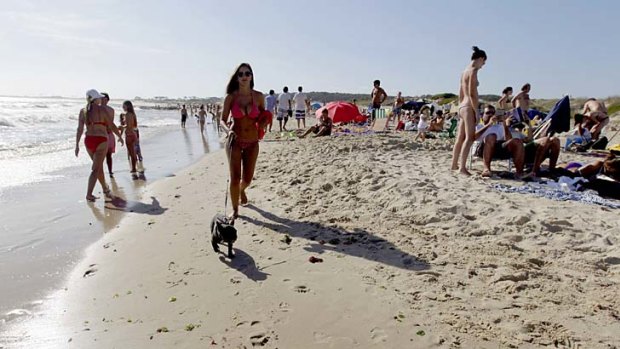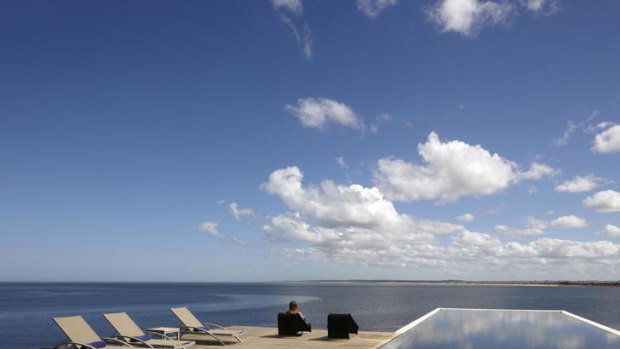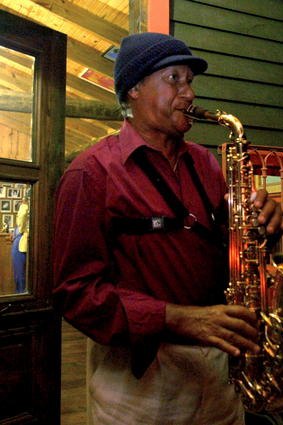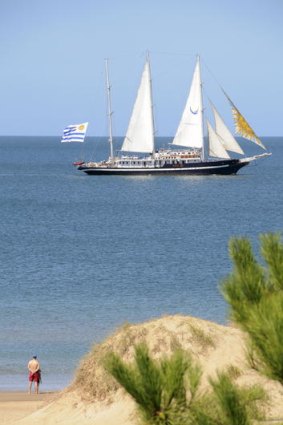
Punta is a state of mind ... Uruguay's coast is an increasingly popular destination.Credit: Reuters
For some, Punta del Este is party central, but for others it's a place that marches to its own drumbeat, writes Aaron Peasley.
WITH its luminous sandy beaches, towering holiday apartment buildings and party-mad reputation, Uruguay's Punta del Este has become one of the undisputed party capitals of South America. The resort's proximity to Argentina has solidified it as the choice summertime refuge of Portenos (natives of Buenos Aires) for decades. Even though summer stretches on for several months, the truly devout won't dream of visiting outside "the season", the brief post-Christmas period when this small but blessed coastal resort is swept into a spectacle of supermodels, oligarchs and all-night parties on the beach.
Punta, as the locals call it, means different things depending who you ask. Some apply a strict geographical appellation, referring to the small city itself, which was founded in 1829. Others use a broader brush, referencing the collection of stylish towns and hamlets that stretch more than 50 kilometres along the country's Atlantic coast.
For others still, Punta is merely a state of mind: a byword for a kind of Latin American chic that marches to its own drumbeat.
You need not visit during the season's apex, when that beat is almost overshadowed by visiting European mega-clubs, to enjoy this increasingly popular destination. During our mid-December visit, there are scant signs of the city's brazen reputation. If anything, with its shuttered restaurants, uninhabited beach and small but touristy artisans market, downtown Punta seems to be reluctantly awakening from a long hibernation.
Fortified by several large scoops of Dulce de Leche ice-cream (an utterly addictive staple in these parts), we set out north along Highway 10. Before long, downtown Punta's garish apartment towers give way to large, single-residence beach houses opening on to wide sandy beaches. Fifteen minutes later, we reach the mouth of Arroyo Maldonado and cross a peculiar, wave-like, undulating bridge that connects to La Barra, a charming little beach community that is both 15 minutes and a world away from downtown's tepid pre-season scene.

Latin chic ... Playa Vik Hotel.
Set back a few blocks from the beach, Casa Zinc is the town's only boutique hotel. With its facade of rusted corrugated iron and haute hodge-podge interiors, the property is every inch the aesthetic of owner Aaron Hojman, a local designer and antiques dealer. Traditional milk jugs and vintage apothecary bottles sit atop old medical filing cabinets; faded back issues of The New Yorker have been stacked into neat towers; and worn but comfy blanket-covered chesterfield sofas are the perfect place to curl up with a book.
When Hojman conceived the charming six-room posada, a short stroll from The Trading Post, his gallery, cafe and antiques store, he was looking for an outlet to showcase his design work and salvage-savant aesthetic: why not let the world come to him?
Today, like much of the region, Casa Zinc draws a design-conscious crowd. Hipsters from Buenos Aires, New York fashion editors and antipodean surfers are all drawn to its special blend of low-key cool. We resist the urge to stay here the entire week. Architecto, our enormous room, which Hojman decorated with the chic restraint of a Bauhaus-trained architect, is the perfect retreat after languid days at the beach. When hunger strikes, we take a five-minute stroll to El Chanco Y La Coneja, a tiny restaurant serving delicious home cooking.

A street musician.Credit: AFP
Beyond La Barra, the coastal road levels off, revealing unbelievably pretty landscapes that blend the rough-and-tumble ranch aesthetic with gold-sand beaches and crystalline waters. About 30 minutes later we arrive in Jose Ignacio, the cute little fishing centre that's become ground zero for the area's increasingly moneyed jet set.
Back in the '70s the village began to lure a few wealthy families from Montevideo and Buenos Aires who built modest houses among the fishing shacks overlooking the pristine beaches. Word spread over the years and, as Punta's high-rise developments began to cannibalise the coast there, in-the-know folk turned their attention further north.
Now Jose Ignacio is far from an insiders' secret, siphoning the rich and famous from other illustrious warm-weather hubs such as St Bart's. Despite one guest's lament, whispered to me over lunch one afternoon, that "this used to be where rich people came to escape other rich people", there seems to be an unspoken covenant against any obvious displays of wealth.

A schooner cruise.Credit: AFP
Here, on Brava beach, you're much more likely to find Havaianas thongs than YSL espadrilles. The dress code, like the hotel rates, is even more relaxed outside the peak summer period.
This year, the property getting all the attention is Playa Vik, owned by New Yorkers Alex and Carrie Vik, who dreamt up the beachfront monolith as a coastal complement to Estancia Vik, their luxe traditional ranch property several kilometres inland.
"We loved the hip, casual cool vibe of Faro Jose Ignacio from our first visit," says Carrie Vik, who, together with her husband, chose a local architect, Carlos Ott, to realise their dream hotel. "We felt strongly that the architect should be someone with a 21st-century avant-garde sensibility."
With its space-age pavilion known as the Sculpture, Playa Vik looks like an oversized consumer product created by Apple designer Jony Ive. The Viks, well known on the glamorous international collecting circuit, have filled the property with important contemporary art.
Despite its tiny size, Uruguay has become a hotbed of the visual arts, producing world-class architects, designers and artists whose work can be found in some of the area's best hotels. During our visit's only overcast day, we take Playa Vik's bikes on a little self-guided architectural tour, which reveals everything from bunker-like villas constructed from untreated cement to effortlessly cool single-level ranchito beach shacks decorated with hammocks, mid-century furniture and sisal rugs.
Uruguayans - and Latin Americans in general - mix and match with prowess. At Fasano Las Piedras, another new and visually exuberant property, treasured antiques and textural accents, many of which were snapped up at Hojman's Trading Post, are balanced against Brazilian architect Isay Weinfeld's starkly beautiful modernist pavilions. What it lacks in jaw-dropping beach vistas, the hotel makes up in visual dazzle and a sybaritic approach to the location: cocktails in the glass-box lounge and long leisurely dinners in the hotel's splendid Italian restaurant.
Nothing happens particularly early in Uruguay. Several friends, on a weekend break from Buenos Aires, scoff when we suggest meeting for dinner at 9 o'clock. Naturally, this is great news for those of us who enjoy a spirited afternoon nap (a necessity after consuming two Clericos, the local take on sangria, during lunch).
Back in Jose Ignacio, the evening meal is a no-brainer: La Huella, an eatery nestled right on the sand, is iconic in these parts. Like its crisp and chic decor, the restaurant's food is uncomplicated: our favourite dishes include simple whole grilled branzino, char-grilled octopus and massive steaks accompanied by smashed potatoes.
Most of Uruguay's best food adheres to the same functional formula. However, for the culinarily inclined, experiencing the Uruguayan coast without visiting El Garzon is akin to going to Napa and not even attempting to get a reservation at the French Laundry. To reach El Garzon, we set out on a dirt road from Jose Ignacio, weaving through working ranches and rolling grass-covered hills. Once we reach the small namesake town it is twilight and there's a distinct frontier feeling.
The fact that it's not a ghost town is due to renowned chef Francis Mallman, who renovated the town's 155-year-old general store to make space for his own vision of what a fine restaurant should be.
Almost a decade ago, the chef, who is known in South America for his quirky television show and trio of acclaimed restaurants, grew tired of fussy and conceptual French culinary gastronomy.
Mallman was drawn back to the kind of unpretentious gaucho cooking he grew up with, re-approaching it in a style he now calls Nuevo Andean. Unimpeachably delicious and deceptively simple, Mallman's food is prepared on a basic open fire, known as an inferniello (little hell), which creates boldly flavoured dishes such as seared rib eye steak paired with Patagonian potato galette.
In keeping with a ritual established more or less the moment I touched Uruguayan soil, our meal climaxes with a scoop of home-made Dulce de Leche ice-cream, insanely rich and delicious.
This marvellous experience has the paradoxical feeling of being both totally extravagant and completely down to earth. The same might be said of Jose Ignacio itself, which still manages to balance its earthy soul against an increasingly fashion-conscious crowd. Brazil, Uruguay's booming neighbour to the north, has made its presence felt with a clutch of new property developments and the burgeoning popularity of tiny string bikinis. Visitors from Australia, the US and Europe are joining the party.
Who can blame them? It's difficult not to be seduced by a daily routine that is bookended by breakfast around noon and long, gregarious dinners at La Huella that wind down some 14 hours later.
"Jose Ignacio has been changing with the influx of foreign travellers in the last 10 years," Carrie Vik tells me, adding that many of the area's locals once lived abroad only to find themselves, like Mallman, retracing their roots back to this sliver of South America.
Trip notes
Getting there
There are daily flights to Punta del Este from Buenos Aires. Qantas flies Sydney to Buenos Aires, 13 13 13, qantas.com. The coastal area is also easily reached by car from Montevideo, Uruguay's capital. Car hire is recommended.
Staying there
Playa Vik has suites from $US1050 ($988). +598 94 605212; playavik.com.
Fasano Las Piedras's guest quarters in freestanding deluxe bungalows start at $US900. +598 42 670000; laspiedrasfasano.com.
Posada Del Faro at Jose Ignacio has rooms from $US250, outside high season. +598 4486 2110, posadadelfaro.com.
See + do
Trading Post, 401/2 Parada, Ruta 10, La Barra;
+598 9962 0066; casazinc.com.
El Chancho Y La Coneja, 12 Calle esq. Ruta 10, La Barra, +598 4277 2497, elchanchoylaconeja.com.
Restaurant La Huella, Playa Brava, Jose Ignacio, paradorlahuella.com; +598 4486 2279.
El Garzon, Plaza e Iglesia, Pueblo Garzo, restaurante garzon.com; +598 410 2811.
More information
Sign up for the Traveller Deals newsletter
Get exclusive travel deals delivered straight to your inbox. Sign up now.